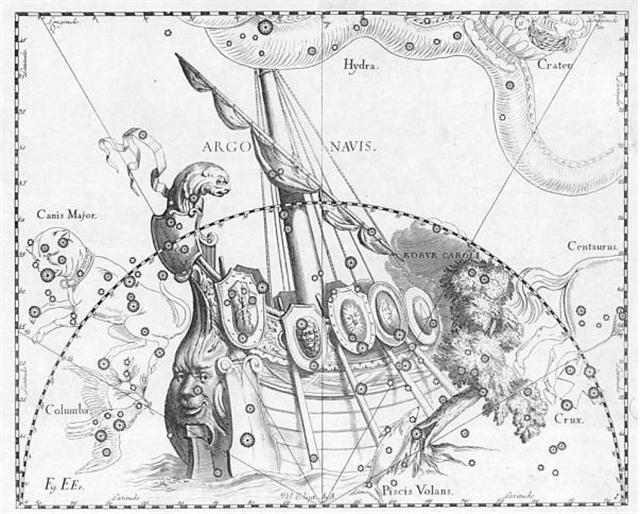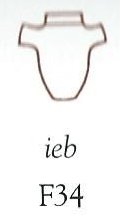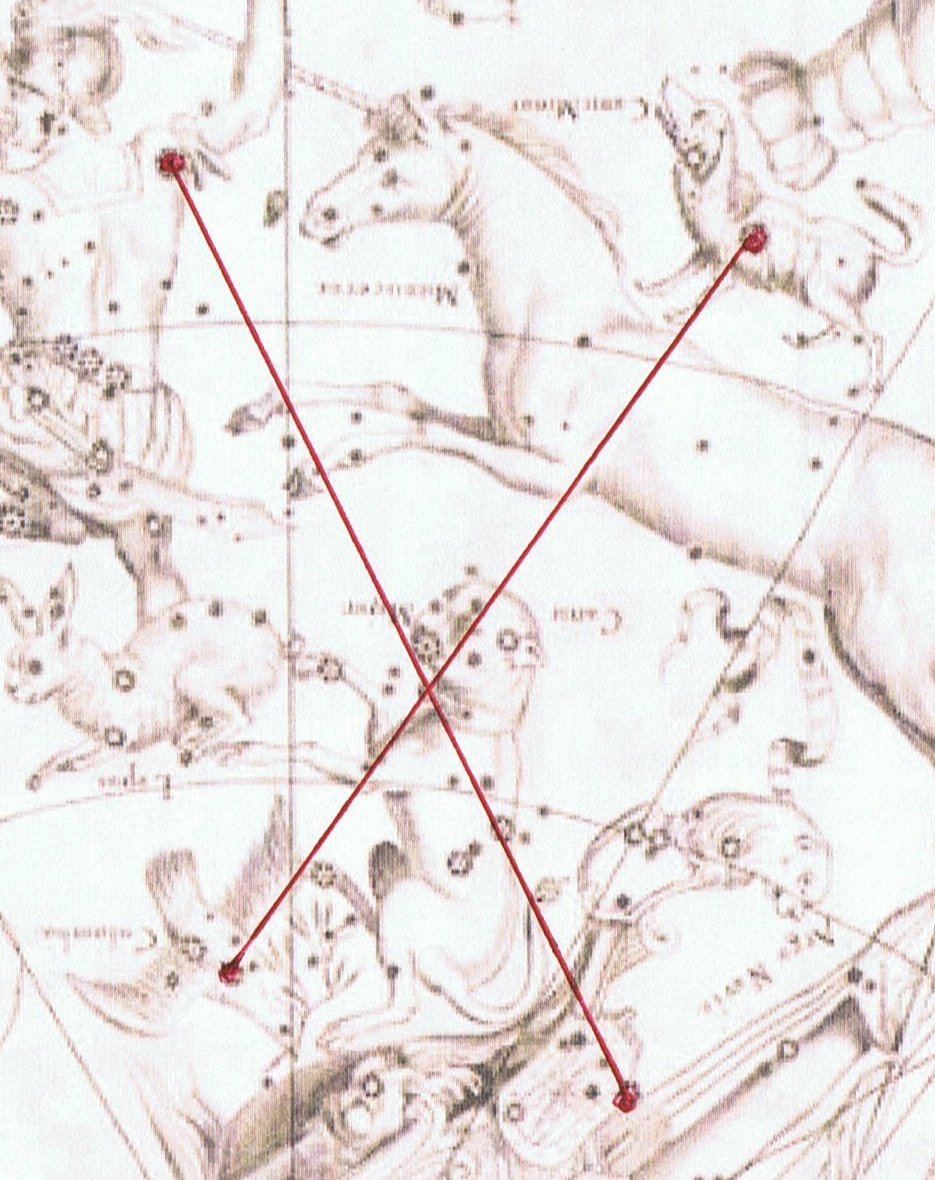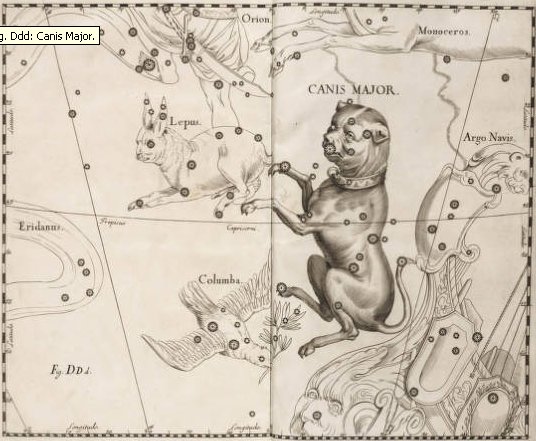The
'gable
of
the house'
- of
Toga-nui
the
grandson
of
Tagaroa
the
little
- could
have
referred
to
the
position
of
the
great
head
above
the
rudder
of
Argo
Navis:

And
the
'heavy
fish'
could
have
alluded
to
Wezen
(δ
at
the
backbone
of
Canis
Major),
which
in
rongorongo
times
was
107
days
after
0h.
There
are 471
glyphs
(days)
on
the
G
tablet
and
471 -
107
=
364
(= 4
*
91).
...
δ,
2.2, light
yellow, is
the modern
Wezen,
from Al
Wezn,
Weight, 'as
the star
seems to
rise with
difficulty
from the
horizon';
but Ideler
calls this
an
astonishing
star name
...
Adara
was
ε at
the
belly
of
the
dog.
...
Al Rescha,
or Al
Rischa,
derived from
the
Arabians'
Al Rishā',
the Cord, is
20º south
from the
head of
Aries, 2º.7
north of the
celestial
equator, and
marks the
knot in the
united cords
of the
Fishes; the
same title
being
applied to β
Andromedae.
This word
originally
may have
come from
the
Babylonian
Riksu, Cord
...
β
[Andromedae]
appeared in
very early
drawings as
the
lucida
of the
northern of
the two
Fishes, and
marked the
26th
manzil
Al Batn
al Hūt,
the Belly of
the Fish, or
Al Kalb
al Hūt,
the Heart of
the Fish;
and the
corresponding
sieu
Goei,
or Kwei,
the Man
Striding, or
the Striding
Legs
anciently
Kwet. In
this
location it
was Al
Rishā,
the Band,
Cord,
Ribbon, or
Thread, as
being on the
line uniting
the Fishes;
but this
title now
belongs to α
Piscium
...
... In the
inscriptions
of Dendera,
published by
Dümichen,
the goddess
Hathor
is called
'lady of
every joy'.
For once,
Dümichen
adds:
Literally
... 'the
lady of
every heart
circuit'.
This is not
to say that
the
Egyptians
had
discovered
the
circulation
of the
blood. But
the
determinative
sign for
'heart'
often
figures as
the plumb
bob at the
end of a
plumb line
coming from
a well-known
astronomical
or surveying
device, the
merkhet.
Evidently,
'heart' is
something
very
specific, as
it were the
'center of
gravity' ...
See Aeg.Wb.
2, pp. 55f.
for sign of
the heart (ib)
as
expressing
generally
'the middle,
the center'.

And this may
lead in
quite
another
direction.
The Arabs
preserved a
name for
Canopus -
besides
calling the
star Kalb
at-tai-man
('heart of
the south')
...
Suhail
el-wezn,
'Canopus
Ponderosus',
the
heavy-weighing
Canopus, a
name
promptly
declared
meaningless
by the
experts, but
which could
well have
belonged to
an archaic
system in
which
Canopus was
the weight
at the end
of the plumb
line, as
befitted its
important
position as
a heavy star
at the South
Pole of the
'waters
below'.
Here is a
chain of
inferences
which might
or might not
be valid,
but it is
allowable to
test it, and
no inference
at all would
come from
the 'lady of
every joy'.
The line
seems to
state that
Hathor
(= Hat
Hor,
'House of
Horus')
'rules' the
revolution
of a
specific
celestial
body -
whether or
not Canopus
is alluded
to - or, if
we can trust
the
translation
'every', the
revolution
of all
celestial
bodies. As
concerns the
identity of
the ruling
lady, the
greater
possibility
speaks for
Sirius, but
Venus cannot
be excluded;
in Mexico,
too, Venus
is called
'heart of
the earth'.
The reader
is invited
to imagine
for himself
what many
thousands of
such
pseudo-primitive
or poetic
interpretations
must lead
to: a
disfigured
interpretation
of Egyptian
intellectual
life
...

 |
 |
 |
 |
| Ga2-9 |
Ga2-10 (40) |
Ga2-11 |
Ga2-12 |
| ●APRIL 18 (*28) |
19 |
20 |
21 (111) |
| APRIL 29 (*39) |
30 |
MAY 1 (121) |
2 |
| Mash-mashu-sha-Risū-10 |
Adara (104.8) |
ω Gemini (105.4), Alzirr (105.7), MULIPHEIN (105.8), Mekbuda (105.9) |
7h (106.5) |
| θ Gemini (103.0), ψ8 Aurigae (103.2), ALHENA (103.8), ψ9 Aurigae (103.9) |
no star listed (106) |
| July 2 |
3 |
4 (185) |
5 |
| ºJune 28 |
29 (*100) |
30 |
ºJuly 1 (182) |
| 'June 5 (156 = 12 * 13) |
6 (*77) |
7 |
8 |
| "May 22 |
23 (*63) |
24 (144) |
25 |
| NAKSHATRA DATES: |
| ●OCTOBER 18 (291) |
19 |
20 |
21 (*214) |
| OCTOBER 29 (*222) |
30 |
31 (304) |
NOVEMBER 1 |
| χ Oct. (286.0), Ain al Rami (286.2), δ Lyrae (286.3), κ Pavonis (286.5), Alya (286.6) |
ξ Sagittarii (287.1), ω Pavonis (287.3), ε Aquilae, ε Cor. Austr., Sulaphat (287.4), λ Lyrae (287.7), Ascella, Bered (Ant.) (287.9) |
Uttara Ashadha-21 |
19h (289.2) |
| NUNKI (288.4), ζ Cor. Austr. (288.5), Manubrium (288.8), ζ Aquilae (288.9) |
λ Aquilae (Ant.) (289.1), γ Cor. Austr (289.3), τ Sagittarii (289.4), ι Lyrae (289.5), δ Cor. Austr. (289.8) |
| January 1 (366) |
2 |
3 |
4 |
| ºDecember 28 |
29 |
30 (364) |
31 (*285) |
| 'December 5 |
6 (340) |
7 (*261 = 9 * 29) |
8 |
| "November 21 (325) |
22 |
23 |
24 (*248) |
 |
 |
 |
 |
 |
| Ga2-13 |
Ga2-14 (44) |
Ga2-15 |
Ga2-16 |
Ga2-17 |
| ●APRIL 22 (*32) |
23 |
24 (114) |
25 |
26 |
| MAY 3 |
4 (*44) |
5 (125) |
6 |
7 |
| WEZEN (107.1), τ Gemini (107.7), δ Monocerotis (107.9) |
no star listed (108) |
λ Gemini (109.4), Wasat (109.8) |
no star listed (110) |
Aludra (111.1), Propus (111.4), Gomeisa (111.6) |
| July 6 |
7 (188) |
8 |
9 |
10 |
| ºJuly 2 |
3 (184) |
4 |
5 |
6 (*107) |
| 'June 9 |
10 (161) |
11 |
12 |
13 (*84) |
| "May 26 |
27 |
28 (*68) |
29 |
30 (150) |
| NAKSHATRA DATES: |
| ●OCTOBER 22 (295) |
23 (*216) |
24 |
25 |
26 |
| NOVEMBER 2 |
3 (*227) |
4 (308) |
5 |
6 |
| Al Baldah-19 / Cargo Boat-91 |
Aladfar (291.1), Nodus II (291.5), ψ Sagittarii (291.6), θ Lyrae (291.8) |
ω Aquilae (292.1), ρ Sagittarii (292.6), υ Sagittarii (292.7) |
Arkab Prior (293.0), Arkab Posterior, Alrami (293.2), χ Sagittarii (293.6) |
Deneb Okab (294.0), α Vulpeculae (294.9) |
| AL BALDAH, ALPHEKKA MERIDIANA (290.1), β Cor. Austr. (290.2) |
| January 5 |
6 |
7 (372) |
8 |
9 |
| ºJanuary 1 |
2 |
3 (368) |
4 |
5 (*290) |
| 'December 9 |
10 (344) |
11 (*265) |
12 |
LUCIA |
| "Nov 25 (329) |
26 (*250) |
27 |
28 |
29 |
Also
Wasat
(δ
Gemini)
meant
'middle'
and
the
10th
Babylonian
ecliptic
station
at
Alhena
(γ
Gemini)
was
in
the
middle
of
their
list
of
20
stations.
The
Egyptian
X
had
the
nose
of
the
Great
Dog
in
the
center:

...
The
brothers
of
Maui
sat
trembling
in
the
middle
of
the
canoe,
fearing
for
their
lives.
For
now
the
water
was
frothing
and
heaving,
and
great
hot
bubbles
were
coming
up,
and
steam,
and
Maui
was
chanting
the
incantation
called
Hiki,
which
makes
heavy
weights
light.
At
length
there
appeared
beside
them
the
gable
and
thatched
roof
of
the
house
of
Tonganui,
and
not
only
the
house,
but
a
huge
piece
of
the
land
attached
to
it.
The
brothers
wailed,
and
beat
their
heads,
as
they
saw
that
Maui
had
fished
up
land,
Te
Ika
a
Maui,
the
fish
of
Maui.
And
there
were
houses
on
it,
and
fires
burning,
and
people
going
about
their
daily
tasks
...
However,
the
'fish'
was
stubborn
and
it
took
some
time
('at
length')
before
he
was
'landed'.
27
days
ahead
counted
from
heliacal
Furud
(ζ
Canis
Majoris at
Rei
in
Ga1-30)
was
the
next
Rei,
at Naos
(ζ)
in
Argo
Navis:
 |
 |
 |
 |
 |
19 |
| Ga1-30 |
Ga2-1 |
Ga2-2 |
Ga2-3 (33) |
Ga2-4 |
| ●APRIL 9 (*19) |
10 (100) |
11 |
12 |
13 |
| APRIL 20 (*30) |
21 (111) |
22 |
23 |
24 |
| Furud (94.9) |
Well-22 / Arkū-sha-pu-u-mash-mashu-9 |
no star listed (96) |
β Monocerotis, ν Gemini (97.0) |
no star listed (98) |
| δ Columbae (95.2), TEJAT POSTERIOR, Mirzam (95.4), CANOPUS (95.6), ε Monocerotis (95.7), ψ1 Aurigae (95.9) |
| June 23 |
ST JOHN'S EVE |
25 |
26 (177) |
27 |
| ºJune 19 |
20 (*91) |
SOLSTICE |
22 (173) |
23 |
| 'May 27 |
28 (*68) |
29 |
30 (150) |
31 |
| "May 13 |
14 (*54) |
15 |
16 (136) |
17 |
| NAKSHATRA DATES: |
| ●OCTOBER 9 |
10 |
11 (*204) |
12 (285) |
13 |
| OCTOBER 20 |
21 |
22 (295) |
23 (*216) |
24 |
| Purva Ashadha-20 |
Kaus Borealis (279.3) |
ν Pavonis (280.4), κ Cor. Austr. (280.9) |
Abhijit-22 |
| KAUS MEDIUS, κ Lyrae (277.5), Tung Hae (277.7) |
φ Oct. (278.1), KAUS AUSTRALIS (278.3), ξ Pavonis (278.4), Al Athfar (278.6) |
θ Cor. Austr. (281.0), VEGA (281.8) |
| December 23 |
CHRISTMAS EVE |
25 |
26 (360) |
27 |
| ºDec 19 (*273) |
20 (354 = 12 * 29½) |
SOLSTICE |
22 |
23 |
| 'Nov 26 (*250) |
27 |
28 |
29 (333) |
30 |
| "Nov 12 (*236) |
13 |
14 |
15 |
16 (320) |
... Furud is either from Al Furud, the Bright Single One, or, perhaps by a transcriber's error, from Al Kurūd, the Apes, referring to the surrounding small stars with some of those of Columba; Ideler thought the latter derivation more probable. Al Sufi mentioned these as Al Agribah, the Ravens. ζ marks the toe of the right hind foot ...
... Murzim, generally but less correctly Mirzam, and occasionally Mirza, is from Al Murzim, the Announcer², often combined by the Arabs with β Canis Minoris in the plural Al Mirzamāni, or as Al Mirzamā al Shi'rayain, the two Sirian Announcers; Ideler's idea of the applicability of this title being that this star announced the immediate rising of the still brighter Sirius.
² Literally the Roarer, and so another of the many words in the Arabic tongue for the lion, of which that people boasted of having four hundred.
Buttmann asserted that it also was Al Kalb, the Dog, running in front of Sirius, but this must have been from early times in the Desert. In our maps it marks the right fore foot of the Dog ...

The last of the empty-handed toga (winter) glyphs was at heliacal φ Gemini (Ga2-24) and then the northern summer would arrive:
| Toga 1. Winter season. Two seasons used to be distinguished in ancient times: hora, summer, and toga, winter. 2. To lean against somehing; to hold something fast; support, post supporting the roof. 3. To throw something with a sudden movement. 4. To feed oneself, to eat enough; e-toga koe ana oho ki te aga, eat well first when you go to work. Vanaga.
1. Winter. P Pau., Mgv.: toga, south. Mq.: tuatoka, east wind. Ta.: toa, south. 2. Column, prop; togatoga, prop, stay. Togariki, northeast wind. Churchill.
Wooden platform for a dead chief: ka tuu i te toga (Bb8-42), when the wooden platform has been erected. Barthel 2.
The expressions Tonga, Kona, Toa (Sam., Haw., Tah.), to indicate the quarter of an island or of the wind, between the south and west, and Tokelau, Toerau, Koolau (Sam., Haw., Tah.), to indicate the opposite directions from north to east - expressions universal throughout Polynesia, and but little modified by subsequent local circumstances - point strongly to a former habitat in lands where the regular monsoons prevailed. Etymologically 'Tonga', 'Kona', contracted from 'To-anga' or 'Ko-ana', signifies 'the setting', seil. of the sun. 'Toke-lau', of which the other forms are merely dialectical variations, signifies 'the cold, chilly sea'. Fornander. |
 |
 |
 |
 |
 |
 |
 |
| Ga2-24 |
Ga2-25 |
Ga2-26 |
Ga2-27 |
Ga2-28 |
Ga2-29 |
Ga3-1 (60) |
| ●MAY 3 |
4 |
5 (125) |
6 (*46) |
7 |
8 |
9 |
| MAY 14 |
15 |
16 (136) |
17 (*57) |
18 |
19 |
20 |
| φ Gemini (118.4) |
Drus (119.9) |
ω Cancri (120.2) |
8h (121.7) |
ρ Puppis (122.0), Heap of Fuel (122.1), ζ Monocerotis (122.3), ψ Cancri (122.6), Regor (122.7) |
Tegmine (123.3) |
Al Tarf (124.3)
Ras Algethi
|
| χ Gemini (121.0), NAOS (121.3) |
| July 17 |
18 |
19 (200) |
20 |
21 |
22 |
23 |
| ºJuly 13 |
14 |
15 |
16 |
17 (*118) |
18 |
19 (200) |
| 'June 20 (*91) |
SOLSTICE |
22 |
23 |
ST JOHN'S EVE |
25 |
26 (177 = 6 * 29½) |
| "June 6 (314 / 2) |
7 |
8 |
9 (*80) |
10 |
11 |
12 |
| NAKSHATRA DATES: |
| ●NOVEMBER 2 |
3 |
4 (308) |
5 (*229) |
6 |
7 |
8 |
| NOVEMBER 13 |
14 (318) |
15 |
16 (*240) |
17 |
18 (322) |
19 |
| ι Sagittarii (301.2), Terebellum, ξ Aquilae (301.3), Alshain (301.6), φ Aquilae (301.8) |
ε Pavonis, θ Sagittarii (302.3), γ Sagittae (302.5), μ Pavonis (302.7) |
τ Aquilae (303.8) |
20h (304.4) |
Shang Wei (305.2), θ Sagittae (305.4), Tseen Foo (305.6), ξ Capricorni (305.8) |
Tso Ke (306.3) |
Gredi (307.2), σ Capricorni (307.5), Alshat (307.9) |
| η Sagittae (304.2), δ Pavonis (304.4) |
| January 16 |
17 |
18 (383) |
19 |
20 |
21 |
22 |
| ºJanuary 12 |
13 (378) |
14 |
15 (*300) |
16 |
17 |
18 |
| 'December 20 |
SOLSTICE |
22 |
23 (*277) |
CHRISTMAS EVE |
25 |
26 |
| "December 6 |
7 |
8 |
9 |
10 (*264) |
11 |
12 (346) |
| Egyptian bread, (-t, female determinant) |
 |
Phoenician qoph |
 |
Greek phi |
Φ(φ) |
|
... is the 21st letter of the Greek alphabet ... Its origin is uncertain but it may be that phi originated as the letter qoppa ... In traditional Greek numerals, phi has a value of 500 or 500000 ...
Isaac Taylor, History of the Alphabet: Semitic Alphabets, Part 1, 2003: 'The old explanation, which has again been revived by Halévy, is that it denotes an 'ape,' the character Q being taken to represent an ape with its tail hanging down. It may also be referred to a Talmudic root which would signify an 'aperture' of some kind, as the 'eye of a needle,' ... Lenormant adopts the more usual explanation that the word means a 'knot' ...
... The king, wearing now a short, stiff archaic mantle, walks in a grave and stately manner to the sanctuary of the wolf-god Upwaut, the 'Opener of the Way', where he anoints the sacred standard and, preceded by this, marches to the palace chapel, into which he disappears. A period of time elapses during which the pharaoh is no longer manifest.

When he reappears he is clothed as in the Narmer palette, wearing the kilt with Hathor belt and bull's tail attatched. In his right hand he holds the flail scepter and in his left, instead of the usual crook of the Good Shepherd, an object resembling a small scroll, called the Will, the House Document, or Secret of the Two Partners, which he exhibits in triumph, proclaiming to all in attendance that it was given him by his dead father Osiris, in the presence of the earth-god Geb. 'I have run', he cries, 'holding the Secret of the Two Partners, the Will that my father has given me before Geb. I have passed through the land and touched the four sides of it. I traverse it as I desire.' ... |
22 / 7 = π was at heliacal Naos.
|














